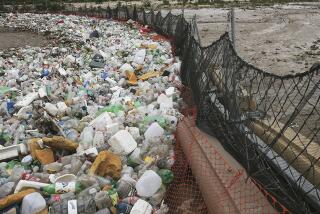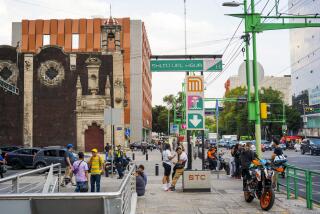Mexico Airport Study Favors Neither Place
- Share via
MEXICO CITY — A long-awaited study considered crucial to deciding the location of Mexico City’s new airport was released Wednesday but carefully avoided favoring either proposed site.
The study by the National Autonomous University, or UNAM, concluded that neither of the two final locations “prevails over the other” in mitigating environmental and safety concerns, said Irma Rosas, director of the university’s environmental program.
With Mexico City’s Benito Juarez International Airport expected to reach saturation in 2006, and with a new airport’s first phase expected to take five years to build, the government is under increasing pressure to choose between the proposed sites in Hidalgo and Mexico states.
President Vicente Fox is expected to make the decision in the coming weeks, based on recommendations from the secretaries of environment and transportation.
Each site has pros and cons, which has made the choice all the more difficult and controversial. The governors of Hidalgo and Mexico states have led costly multimillion-dollar lobbying and marketing campaigns in recent months, each eyeing the airport as a generator of fabulous economic benefits to his state.
The Hidalgo state site, in Tizayuca about 35 miles north of downtown Mexico City, is less convenient than Texcoco in Mexico state, which is about 20 miles to the east. But the more distant site is generally viewed as less costly to build on and more environmentally friendly.
The Tizayuca site would operate in tandem with the existing Mexico City airport, which would remain open to handle domestic flights. The Texcoco site would require the closure of the existing airport because of their proximity and would cost more to build on.
Although several of the study’s eight component reports seemed to favor the Tizayuca location, the site’s environmental advantages were not compelling enough to cause the authors to state a clear preference.
“We concluded that neither of the two choices are favorable over the other,” said researcher Luis Antonio Bojorquez.
A Tizayuca airport might grant Mexico City a “breather” from unrelenting urban sprawl by luring growth away from the capital whereas a Texcoco location might intensify the city’s growth, noted UNAM urban researcher Javier Delgado.
The study seemed to please neither the Tizayuca nor the Texcoco camp, each of which was hoping for a clear preference from UNAM.
“When one thinks that everything is equal, it is like having no opinion at all,” said Roberto Eibenschutz Hartman, an urban planner and consultant to Hidalgo state. He noted that UNAM did a similar study in 1995 that considered six airport locations, ranking Tizayuca the most environmentally friendly, with Texcoco last.
Fernando D’Acosta Lopez, an architect and consultant to the state of Mexico pushing the Texcoco site, said the study failed to look at long-term impacts of the two sites on water supplies in the Valley of Mexico, which would have put his site in a favorable light.
“I understand why they didn’t make a recommendation because it’s not their job as a neutral entity,” D’Acosta Lopez said. “They can’t take sides. It would have compromised the neutrality of the university.”
Pilots, air traffic controllers and aeronautical engineering groups came out in March in favor of the Texcoco site, which on average takes 18 minutes less to reach by car from downtown Mexico City than the Tizayuca site, according to the UNAM study.
Environmentalists fear that an airport at the closer location, though more convenient, would destroy nesting sites for 27 species of migratory birds in Lake Texcoco. The birds also could present flight hazards to aircraft. The lake has been reclaimed during the last 30 years after drying up earlier in the century.
A group of Mexican environmentalists made an eleventh-hour visit to the United States last week to try to drum up support among U.S. environmental groups for the Tizayuca site. Biologist Laura Martinelli of the Bioetica conservation group told the Americans that a Texcoco airport would destroy the habitat of animals and plants in what is now a natural lagoon.
Mexico City’s existing airport hosts about 300,000 aircraft landings and takeoffs a year, and it’s expected to reach its limit of 360,000 in five years.
Environment and Natural Resources Secretary Victor Lichtinger said the presentation of the report Wednesday showed the government’s commitment to make the selection “serious and transparent based on technical reasons.”
More to Read
Sign up for Essential California
The most important California stories and recommendations in your inbox every morning.
You may occasionally receive promotional content from the Los Angeles Times.













